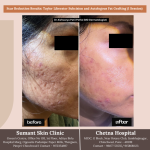Have you noticed that reading your phone, a book, or even a restaurant menu has become more difficult over the years? Do you find yourself holding items farther away just to see clearly? If yes, you’re likely experiencing presbyopia, a very common and completely natural age-related eye condition.
What Is Presbyopia?
Presbyopia is the gradual loss of your eyes’ ability to focus on nearby objects. It’s not a disease but a natural part of the aging process, usually beginning around the age of 40 and continuing to progress until about age 65.
Why Does It Happen?
Inside our eyes is a flexible, clear structure called the lens. This lens changes shape to focus on objects at various distances — a process known as accommodation. When we’re young, the lens easily adjusts to focus both near and far.
As we age, however, the lens begins to harden and loses its elasticity. The surrounding muscles that help change the lens shape also weaken. This reduced flexibility makes it difficult for the eye to focus on nearby objects, leading to blurry near vision.
Common Symptoms of Presbyopia
Presbyopia develops gradually, so you may not notice it immediately. However, common signs include:
- Difficulty reading small print
- Holding books, phones, or newspapers farther away to read clearly
- Eye strain or headaches after doing close-up work
- Needing brighter lighting for reading
These symptoms may become more noticeable in low-light situations or after long periods of reading or screen use.
How Is Presbyopia Different from Other Vision Problems?
Unlike nearsightedness (myopia), farsightedness (hyperopia), or astigmatism, presbyopia is age-related and affects everyone eventually — even if you’ve never had vision problems before.
Treatment Options
Although presbyopia can’t be cured, it can be easily managed with corrective solutions tailored to your lifestyle. Some common options include:
- Reading Glasses: Ideal for people who have good distance vision but need help only with near tasks like reading or sewing.
- Bifocal or Progressive Lenses: These glasses offer correction for both near and distant vision without the need to switch between pairs.
- Contact Lenses: Multifocal or monovision lenses can help people who prefer not to wear glasses.
- Surgical Options: Refractive surgery, lens implants, or conductive keratoplasty are advanced options for those looking for more permanent solutions.
When to See an Eye Doctor
If you’re over 40 and notice changes in your near vision, schedule an eye examination. Early detection and proper prescription lenses can greatly improve your comfort and quality of life.
Conclusion
Presbyopia is a normal part of aging, but that doesn’t mean you have to live with blurred near vision. With the right care and correction, you can continue enjoying all the activities you love — from reading your favorite book to working on your computer.
👁️🗨️ Take the first step—book your eye test today!
For Consultation Contact us on 9168690448 / 9158681123
Website – www.chetnahospital.co.in
Address – Chetna Hospital, Sambhajinagar, MIDC, G Block, Near Rotary Club, Chinchwad 411019
.
.
.
#hospital#pune#pcmc#chinchwad#medical#medicalservices#dryeyetreatment#dryeyerelief#dryeyedisease#dryeyetherapy#catract#catractsurgery#catracteyesurgery#catracteyeoperation#eyedoctor#eye#glaucoma#conjunctivitis#ophthalmologist#eyediseases#eyepain#pinkeye#hazeleyes#myopia#eyeinfection#amblyopia#dryeyesyndrome#eyeproblems#motibindu#motibinduoperation













